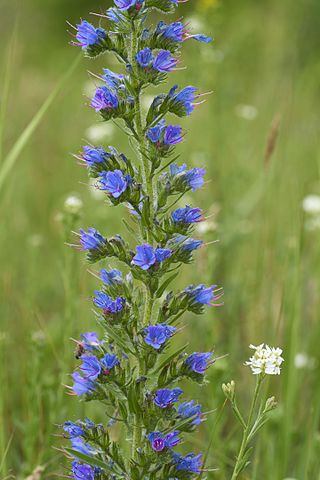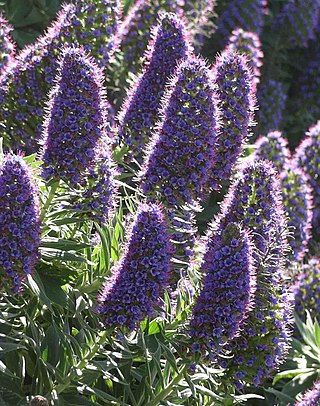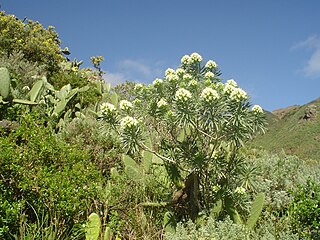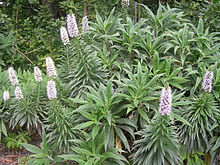
A raceme or racemoid is an unbranched, indeterminate type of inflorescence bearing flowers having short floral stalks along the shoots that bear the flowers. The oldest flowers grow close to the base and new flowers are produced as the shoot grows in height, with no predetermined growth limit. Examples of racemes occur on mustard, radish, and orchid plants.

Echium vulgare, known as viper's bugloss and blueweed, is a species of flowering plant in the borage family Boraginaceae. It is native to most of Europe and western and central Asia and it occurs as an introduced species in north-eastern North America, south-western South America and the South and North Island of New Zealand. The plant root was used in ancient times as a treatment for snake or viper bites. If eaten, the plant is toxic to horses and cattle through the accumulation of pyrrolizidine alkaloids in the liver.

Chamaerops is a genus of flowering plants in the family Arecaceae. It contains only one species, Chamaerops humilis, variously called European fan palm or the Mediterranean dwarf palm. It is one of the most cold-hardy palms and is used in landscaping in temperate climates.

Anaga massif is a mountain range in the northeastern part of the island of Tenerife in the Canary Islands. The highest point is 1,024 m. It stretches from the Punta de Anaga in the northeast to Cruz del Carmen in the southwest. Anaga features the mountain peaks of Bichuelo, Anambro, Chinobre, Pico Limante, Cruz de Taborno and Cruz del Carmen. The mountains were formed by a volcanic eruption about 7 to 9 million years ago making it the oldest part of the island. Since 1987 it has been protected as a "natural park", reclassified as "rural park" in 1994. Since 2015 it is also an UNESCO Biosphere Reserve and is the place that has the largest number of endemic species in Europe.
Tower of jewels may refer to:

Echium is a genus of flowering plants in the family Boraginaceae that contains about 70 species and several subspecies.

Echium simplex, commonly known as tower of jewels, is a herbaceous biennial plant which grows up to 3m in height.

Echium wildpretii is a species of flowering plant in the family Boraginaceae. It is an herbaceous biennial plant that grows up to 3 m (10 ft) in height. The species is endemic to the Canary Islands, and is found mainly in the national park surrounding Mount Teide in Tenerife. The subspecies E. wildpretii subsp. trichosiphon occurs at high altitudes on the island of La Palma. The common names are tower of jewels, red bugloss, Tenerife bugloss or Mount Teide bugloss.

Echium candicans, the 'Pride of Madeira', is a species of flowering plant in the family Boraginaceae, and genus Echium, native to the island of Madeira. It is a large herbaceous perennial subshrub, growing to 1.5–2.5 m.
Senecio lamarckianus, the bois de chèvre, is a species of flowering plant in the aster family. It is endemic to the island of Mauritius and is threatened by habitat loss. It is named for the French philosopher, botanist and zoologist Jean-Baptiste Lamarck.

Echium pininana, commonly known as the tree echium, pine echium, giant viper's-bugloss, or tower of jewels, is a species of flowering plant in the borage family Boraginaceae. It is endemic to the Canary Islands, where it is restricted to the island of La Palma. Echium pininana is an endangered species, and is listed in Appendix I to, and is therefore protected under, the Convention on the Conservation of European Wildlife and Natural Habitats. The specific epithet pininana is Latin for "small pine", though E. pininana is neither closely related to the pine, nor does it resemble that plant.

Juncus scheuchzerioides is a species of rush variously called short rush or greater rush. It has an Antarctic circumpolar distribution and is native to many subantarctic islands in, and on the regions bordering, the Southern Ocean.

Bulbinella rossii, commonly known as the Ross lily, is a species of flowering plant in the genus Bulbinella. Despite its common name, it does not belong to the lily family Liliaceae. It is one of the subantarctic megaherbs. The specific epithet honours British Antarctic explorer James Clark Ross, who visited Campbell Island in December 1840. Bulbinella rossii is featured on the reverse of the current five dollar New Zealand banknote.

Sonchus acaulis is a plant species in the tribe Cichorieae within the family Asteraceae. It is found only on the Canary Islands of Gran Canaria and Tenerife.

Dracophyllum fitzgeraldii, commonly known as the Fitzgeraldii tree or Fitzgerald tree, is a flowering plant in the family Ericaceae. It is endemic to Lord Howe Island, though its closest relatives are species native to northern Queensland and to New Caledonia.

Darwinia virescens, commonly known as Murchison darwinia, is a species of flowering plant in the family Myrtaceae and is endemic to a small area on the west coast of Western Australia near Geraldton. It is a prostrate or low-lying shrub with crowded linear leaves and dense, hemispherical heads of green, yellow or red flowers.

Echium aculeatum is a species of flowering plant of the family Boraginaceae. It is endemic to the Canary Islands, where it occurs on the islands El Hierro, La Palma, La Gomera and Tenerife. Its name in Spanish is ajinajo.

Echium nervosum is a species of flowering plants of the family Boraginaceae. It is endemic to Madeira. The specific name nervosum is from Latin and means "veined".

Echium leucophaeum is a species of flowering plants of the family Boraginaceae. It is endemic to the Canary Islands, where it is restricted to the island of Tenerife. Its name in Spanish is taginaste de Anaga. The specific name leucophaeum is from Greek and means "greyish white".

Echium judaeum, commonly known as the Judean viper's bugloss, is an annual plant endemic to southern Lebanon, southern Syria and Israel, of the Boraginaceae family, and which, like other herbaceous flowering plants of the same genus, derives its name from the style's resemblance to the forked-tongue of a serpent during the flower's pistillate-stage of development.



















